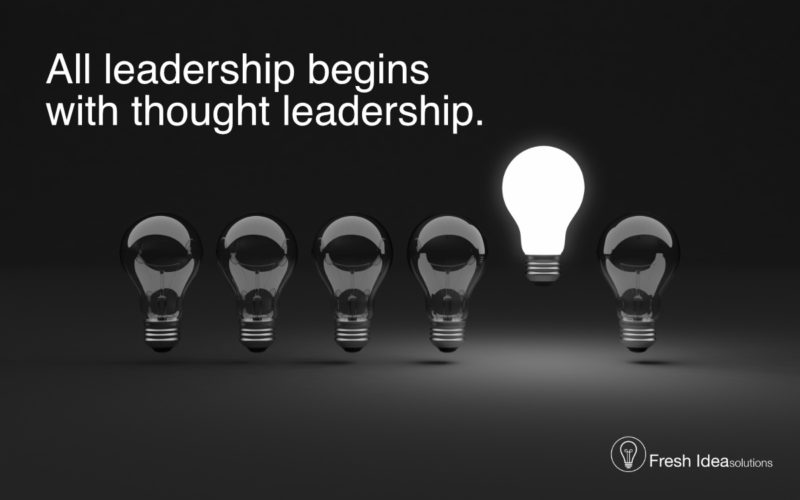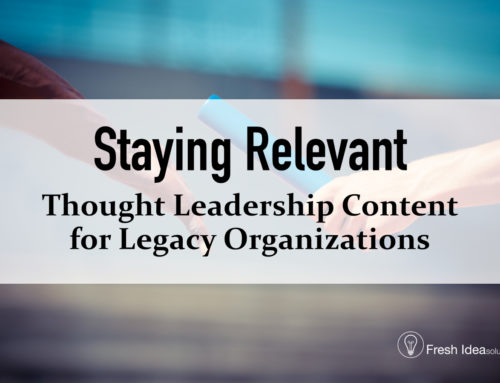As a leader, part of your “job” is to create a corporate culture favorable for growth. Inspire action and get your people working together with thought leadership content.
If you’ve followed the conversation on leadership or organizational development for long, you’ve heard about the importance of corporate culture. And you know that successful leaders are primarily concerned with developing a corporate culture makes creativity, growth, and progress sprout organically like a greenhouse makes conditions just right for flowers to grow in adverse climates.
What is corporate culture?
Corporate culture is the overall mood, the esprit de corps, of an organization created by the sum total of the beliefs, decisions, feelings, and actions taken by the people within it. It is the intangible, abstract characteristic of your organization that is felt more easily than it can be measured.
Corporate culture is often expressed verbally like this…
“This is how we do things around here.”
“I don’t know, but we’ve always done it that way.”
“That’ll never work. It’s just not us.”
No matter how big or small your institution or company is, your corporate culture can either stimulate or stifle growth and innovation.
Growth Mindset vs. Fixed Mindset
 Recently, my friend Taylor Shanklin shared a podcast with me where she and her colleague at Pursuant, Leah Davenport, talked about fixed versus growth mindsets.
Recently, my friend Taylor Shanklin shared a podcast with me where she and her colleague at Pursuant, Leah Davenport, talked about fixed versus growth mindsets.
After describing the danger of having a fixed mindset within your organization, they discussed how nonprofits can break through into a growth mindset that prompts innovation, collaboration, and progress.
A mindset is just another way to say corporate culture. If you have a fixed mindset in your nonprofit or educational institution, you have a stagnate culture that will thwart any new ideas or strategies.
“All that,” explains Leah Davenport, “starts in the mind.”
Our brains love patterns and habits. What are our habits — not only in our behaviors — but what are our mental habits?
What are some of the things you do day to day that might be stifling your growth?
One of the most debilitating mental and behavioral habits (a.k.a., corporate culture) an organization or company can have is keeping departments separated in tightly guarded silos.
“Break down the silos…”
Closed teams that never interact or allow input from the other departments in an organization have to do everything on their own.
They have to figure out their own problems. They have to recruit their own staff. They have to fight for their resources. They don’t want other teams getting credit for their projects.
It’s an “us and them” mentality. But there’s hope even if you have a divided corporate culture!
“So if you at your nonprofit are thinking about how do I [create a growth mindset in my organization], one of the ways is break down the walls, break down the silos, between the departments in your organization. Get people working together cross-departmentally. In the for-profit space, we see this in the form of growth teams where they’re developing growth teams that bring together IT, product, and marketing — all of them working together to solve one problem.”
Now Taylor would be the first to admit that breaking down the silos is easier said than done.
However, it still needs to be the destination!
All of us working together for the win — this is a growth mindset, a positive corporate culture.
After hearing their conversation, I began thinking how long-form, thought leadership content helps turn poor performing cultures into thriving cultures.
Thought Leadership Content = Culture Change Catalyst
Executive leadership has to inject new ways of thinking into the organization in a way that wins over the minds of leaders within the various teams to begin changing corporate culture in a positive, innovative direction.
Leaders sow new ideas into their organizations using thought leadership content like books, podcasts, videos, inspirational emails, live presentations, and more.
Of course, you already know this. You…
- Read books that change your mind.
- Listen to podcasts that change the way you think.
- Follow thought leaders who challenge your presuppositions and perspective.
Strangely, this common sense approach contradicts much of the advice you’ll find out there.
For instance, some consultants will tell you to start by modifying behaviors, as Jon Katzenbach does in the video below.
He recommends encouraging key leaders in your organization to change specific behaviors, such as how they conduct meetings to change the corporate culture. The idea is that their behavior will eventually catch on with other people in the organization and Voila! You’ve got culture change.
Although I’d never want to argue with Mr. Katzenbach, I don’t believe behavior modification is enough… or even the right place to start.
Behavioral modification is not enough.
I’ve worked in siloed, fragmented organizations where new policies and behavioral codes changed with the weather, yet we stayed in our rut.
We were a legacy organization with decades of history through some of the world’s biggest crises.
By the time I got there, many departments had been instituted ad hoc to meet the internal and external forces that came and went throughout the institution’s lifetime.
The only ones who knew why these teams and programs existed in the first place were the executives. Unfortunately, they didn’t have time to explain the WHY to the other teams.
The lack of clarity around the purpose of the new departments led to unending cycles of fighting for limited resources. Team leaders guarded critical information instead of sharing it. Each department did their same old projects the same old way.
For example, the organization was in its 60th year before we decided to run on a budget.
Before that, the CEO looked at the organization’s checkbook to see how much money was in the bank. If the funds were there, the project was a go.
Like so many nonprofits, innovation progressed at snail’s pace.
In my four years there, I saw countless policy changes — but things continued the same.
Behavioral modification doesn’t lead to cultural change.
Lead what matters.
Leadership is leading people from one place to another. Some leaders do this literally, like Charlton Heston — I mean, Moses, leading the children of Israel out of Egypt.
But the first place a leader leads is in the mind.
Using the example above, Moses had to inspire his people to dream of a life without masters. He had to convince them to trust him. He had to remind them of their innate potential for greatness.
In every one of these areas, Moses led his people into a new way of thinking. The new thinking changed their culture. Soon, the fledgling Israelite culture became action.
Thought leadership isn’t a type of leadership. It’s where all leadership begins.
Therefore, why would you spend all your time trying to lead different actions?
Lead what matters.
Start by leading the heart. Then, lead the way your people think.
The actions, decisions, and innovations you’re looking for will follow.
For me, this is the most difficult, most perilous place to lead.
It takes time to write a thought leadership book that builds trust. It takes massive energy to wrestle with what makes your organization still relevant, why your people should remain devoted to the cause. It’s a lot of work finding compelling stories to inspire growth in your organization, donor base, or cause.
But my friend, you must do it. You must do it to change your corporate culture and see the change in this world you signed up for.
And if you need some help, I’m here for you.









Leave A Comment